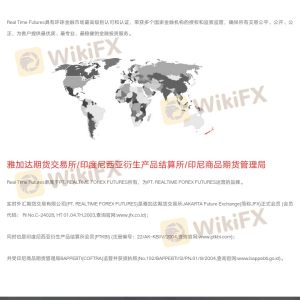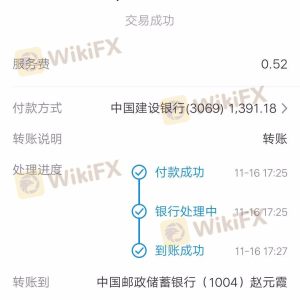Regarding the legitimacy of MDF forex brokers, it provides FCA and WikiBit, (also has a graphic survey regarding security).
Is MDF safe?
Rating Index
Business

License

Is MDF markets regulated?
The regulatory license is the strongest proof.
FCA Appointed Representative (AR)
Financial Conduct Authority
Financial Conduct Authority
Current Status:
UnverifiedLicense Type:
Appointed Representative (AR)
Licensed Entity:
MDF Capital Limited
Effective Date:
2016-12-01Email Address of Licensed Institution:
rahul.kirpalani@gmail.comSharing Status:
No SharingWebsite of Licensed Institution:
--Expiration Time:
2017-09-28Address of Licensed Institution:
5 Harbour ExchanGe Square London E14 9GE UNITED KINGDOMPhone Number of Licensed Institution:
44 07955350428Licensed Institution Certified Documents:


Is MDF Safe or Scam?
Introduction
MDF Forex, a brand under Market Direct Forex, positions itself as a competitive player in the forex trading market, offering various trading accounts and a selection of over 40 currency pairs. However, as the forex market is fraught with risks, traders must exercise caution when choosing a broker. The importance of evaluating a broker's credibility cannot be overstated, as many traders have fallen victim to scams that can lead to significant financial losses. This article aims to provide an objective assessment of whether MDF Forex is a scam or a safe trading option. The investigation is based on a thorough analysis of regulatory compliance, company background, trading conditions, customer experiences, and overall risk assessment.
Regulation and Legitimacy
A broker's regulatory status is crucial in determining its legitimacy. MDF Forex operates under New Zealand's regulatory framework and is registered with the Financial Service Providers Register (FSPR). It is also subject to oversight by the Financial Markets Authority (FMA), which ensures that brokers adhere to strict financial standards. Below is a summary of MDF Forex's regulatory information:
| Regulatory Authority | License Number | Regulatory Region | Verification Status |
|---|---|---|---|
| Financial Markets Authority (FMA) | N/A | New Zealand | Verified |
The FMA requires brokers to maintain a minimum net tangible asset amount of at least $1,000,000 and comply with professional indemnity insurance standards. This regulatory framework adds a layer of protection for traders, as regulated brokers must adhere to transparency and operational integrity. Furthermore, MDF Forex is a member of the Financial Services Complaints Limited, providing an independent dispute resolution mechanism for clients.
However, while the regulatory status of MDF Forex appears solid, it is essential to consider the quality of regulation. New Zealand's regulatory environment is generally considered less stringent than that of other jurisdictions like the FCA or ASIC. Therefore, while MDF Forex is regulated, traders should remain vigilant and aware of the potential risks associated with trading with a broker operating under a less rigorous regulatory framework.
Company Background Investigation
MDF Forex, established under Market Direct Forex, has a relatively short history in the forex market. The company's ownership structure and management team play a significant role in its operations. While specific details about the management team are limited, the company's emphasis on transparency and compliance suggests that it is committed to maintaining a reputable standing in the industry.
The lack of comprehensive information about the company's history raises concerns about its transparency. A broker's credibility is often linked to its operational history, and without a clear understanding of its development, traders may question the broker's reliability. Furthermore, the absence of publicly available information regarding the company's ownership can lead to skepticism about its intentions.
In summary, while MDF Forex is regulated and appears to operate within legal frameworks, the limited information available about its management and operational history may cause potential clients to question its credibility. Traders should weigh these factors carefully when considering whether MDF Forex is safe or potentially a scam.
Trading Conditions Analysis
One of the critical aspects of evaluating a forex broker is understanding its trading conditions, including fees, spreads, and commissions. MDF Forex offers four types of live trading accounts, ranging from normal to VIP accounts, with varying minimum deposit requirements. The overall fee structure is essential for traders to assess the cost-effectiveness of their trading activities.
MDF Forex's spreads are reported to be around 2 pips for major currency pairs, which is within the industry average. However, the lack of specific information regarding the "normal" account's spreads may raise concerns for retail traders. Below is a comparison of core trading costs:
| Cost Type | MDF Forex | Industry Average |
|---|---|---|
| Major Currency Pair Spread | 2 pips | 1.5 - 3 pips |
| Commission Model | Varies | Varies |
| Overnight Interest Range | Varies | Varies |
The absence of a clear commission structure can be a red flag for potential clients, as it may indicate hidden fees or unexpected costs. Furthermore, the minimum deposit requirements for premium and VIP accounts are significantly higher than for other brokers, which could be a tactic to attract institutional clients rather than retail traders.
In conclusion, while MDF Forex's trading conditions appear competitive, the lack of transparency regarding commission structures and minimum deposit requirements may lead traders to question the overall value of trading with this broker. Therefore, it is essential to conduct thorough research to determine if MDF Forex is truly safe for trading.
Customer Funds Safety
The security of customer funds is paramount in the forex trading industry. MDF Forex claims to implement several measures to safeguard client funds, including segregated accounts and investor protection policies. Segregating client funds from the company's operational funds is vital in ensuring that traders' money is not used for operational expenses, thereby providing a level of security in the event of financial difficulties.
However, it is crucial to delve deeper into the specifics of these safety measures. For instance, while MDF Forex adheres to the regulatory requirements set forth by the FMA, the effectiveness of these measures is contingent upon the broker's compliance with best practices in fund management. Additionally, the absence of a negative balance protection policy may expose traders to significant risks, especially during volatile market conditions.
Historically, there have been complaints regarding fund withdrawals and access to accounts, which raises concerns about the reliability of MDF Forex's fund safety measures. In the forex industry, brokers with a history of customer complaints regarding fund access or withdrawal issues may be viewed with skepticism.
In summary, while MDF Forex claims to prioritize fund safety, potential clients should carefully consider the broker's history and the effectiveness of its safety measures. Understanding whether MDF Forex is truly safe for trading requires evaluating the broker's commitment to safeguarding customer funds and its track record in addressing client concerns.
Customer Experience and Complaints
Customer feedback is an invaluable resource when assessing the reliability of a forex broker. Reviews and testimonials from real users provide insights into the broker's performance, customer service, and overall user experience. For MDF Forex, customer experiences appear to be mixed, with some clients praising the broker's trading conditions while others express dissatisfaction with service quality.
Common complaints about MDF Forex include issues related to withdrawal processes, delayed responses from customer support, and difficulties accessing accounts. Below is a summary of the primary complaint types and their severity:
| Complaint Type | Severity Level | Company Response |
|---|---|---|
| Withdrawal Issues | High | Slow response |
| Customer Support Delays | Medium | Inconsistent |
| Account Access Problems | High | Poor communication |
One notable case involved a client who reported difficulties withdrawing funds from their account, resulting in frustration and a lack of trust in the broker's operations. Such complaints highlight the importance of assessing a broker's responsiveness and reliability, as these factors are critical in maintaining a positive trading experience.
In conclusion, while MDF Forex has attracted some positive feedback, the prevalence of complaints regarding withdrawals and customer support raises concerns about the broker's overall reliability. Traders should exercise caution and consider these factors when determining if MDF Forex is safe or potentially a scam.
Platform and Trade Execution
The performance and reliability of a trading platform are crucial for a successful trading experience. MDF Forex offers the widely-used MetaTrader 4 (MT4) platform, which is known for its user-friendly interface and robust trading features. However, the platform's performance, including order execution quality and slippage rates, must be evaluated to determine its reliability.
Reports from users indicate that while the MT4 platform is generally stable, some traders have experienced slippage during high volatility periods. This can be particularly concerning for traders who rely on precise entry and exit points. Additionally, any signs of platform manipulation or irregularities in order execution can significantly impact a trader's experience and profitability.
In summary, while MDF Forex provides access to a reputable trading platform, traders should remain vigilant regarding potential execution issues and slippage. Evaluating the platform's performance and reliability is essential in determining if MDF Forex is a safe option for trading.
Risk Assessment
Using MDF Forex as a trading platform involves various risks that traders should carefully consider. Understanding these risks is crucial for making informed trading decisions. Below is a summary of the key risk areas associated with MDF Forex:
| Risk Category | Risk Level (Low/Medium/High) | Brief Description |
|---|---|---|
| Regulatory Risk | Medium | Operates under New Zealand regulations, which may be less stringent than other jurisdictions. |
| Fund Safety Risk | High | Complaints related to withdrawals and fund access raise concerns about fund safety. |
| Execution Risk | Medium | Potential slippage and execution delays during high volatility periods. |
| Transparency Risk | High | Limited information about company ownership and management raises transparency concerns. |
To mitigate these risks, traders should conduct thorough research before trading with MDF Forex. This includes understanding the broker's regulatory status, customer feedback, and the overall trading environment. Additionally, traders should consider setting strict risk management strategies, such as using stop-loss orders and limiting their exposure.
Conclusion and Recommendations
In conclusion, the investigation into MDF Forex reveals a mixed picture regarding its safety and legitimacy. While the broker is regulated in New Zealand and offers competitive trading conditions, several red flags warrant caution. Complaints related to fund withdrawals, limited transparency, and execution issues raise concerns about the overall reliability of MDF Forex.
For traders considering using MDF Forex, it is essential to weigh these factors carefully. While some may find the broker's offerings appealing, others may prefer to seek alternatives with a stronger regulatory framework and a proven track record of customer satisfaction. Recommended alternatives include brokers like XM, FXPro, and eToro, which are known for their robust regulatory environments and positive customer feedback.
Ultimately, whether MDF Forex is safe or a scam depends on individual risk tolerance and trading preferences. Traders are encouraged to conduct thorough research, remain vigilant, and prioritize their financial safety in the forex market.




MDF Similar Brokers Safe
Whether it is a legitimate broker to see if the market is regulated; start investing in Forex App whether it is safe or a scam, check whether there is a license.
MDF latest industry rating score is 1.61, the higher the score the safer it is out of 10, the more regulatory licenses the more legitimate it is. 1.61 If the score is too low, there is a risk of being scammed, please pay attention to the choice to avoid.
